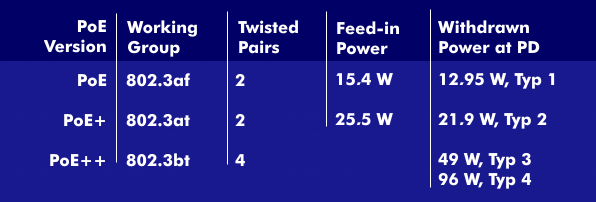IEEE 802.3at
The IEEE working group802.3af deals with the topic of Power over Ethernet( PoE). Since the supply power of 15.4 W specified by the 802.3af working group is not sufficient for many applications, the 802.3at working group is also dealing with this topic, but it is about PoE+ with a transmittable power of 30 W. Of the 30 W, 25.5 W is available to the powered device( PD), and the remaining 4.5 W is the power dissipation of the cabling.
PoE+ (PoEPlus) can use category 3 to 5 TP cables as physical media. However, Cat 5e or higher is suggested for implementation. The reason for this is the lower ohmic resistance of these TP cables, which is 25 ohms for 100 m loop lengths, compared to 40 ohms for lower categories. For Industrial Ethernet, it should be noted that the Industrial RJ45 connector offers four wire pairs, whereas the often used M12 connector only supports two wire pairs. This fact is not important for the application, since the signals and the power supply can be transmitted via one line pair each, but it is for the conductor resistance.
This work is interesting for IP-basedvideo surveillance because the surveillance systems can be powered directly via PoE+.
If the power of 802.3at is not sufficient, there is a PoE method with 4 Pair Power over Ethernet( 4PPoE) that works with four pairs of wires and supports the four power classes 5, 6, 7 and 8 with power values of 45 W, 60 W, 75 W and 90 W. The standard is 802.3bt.

